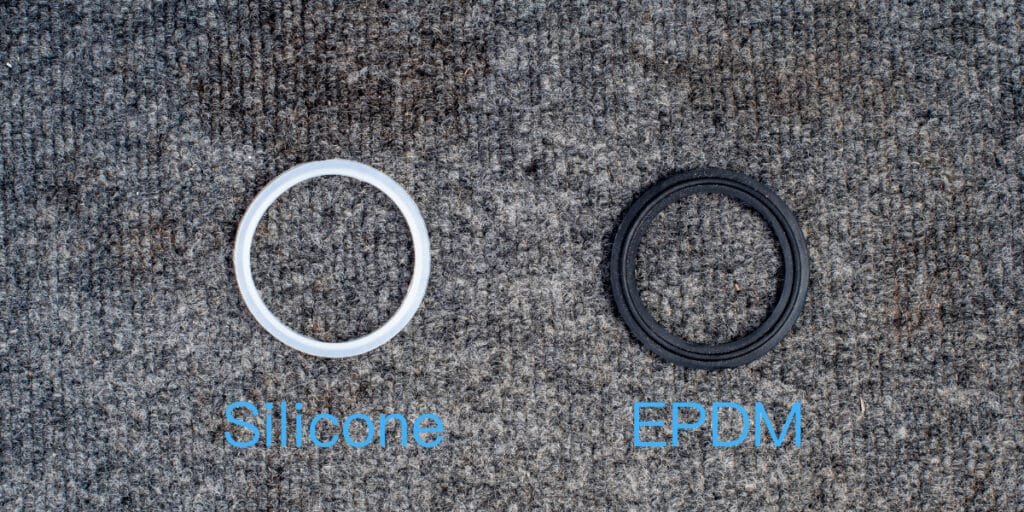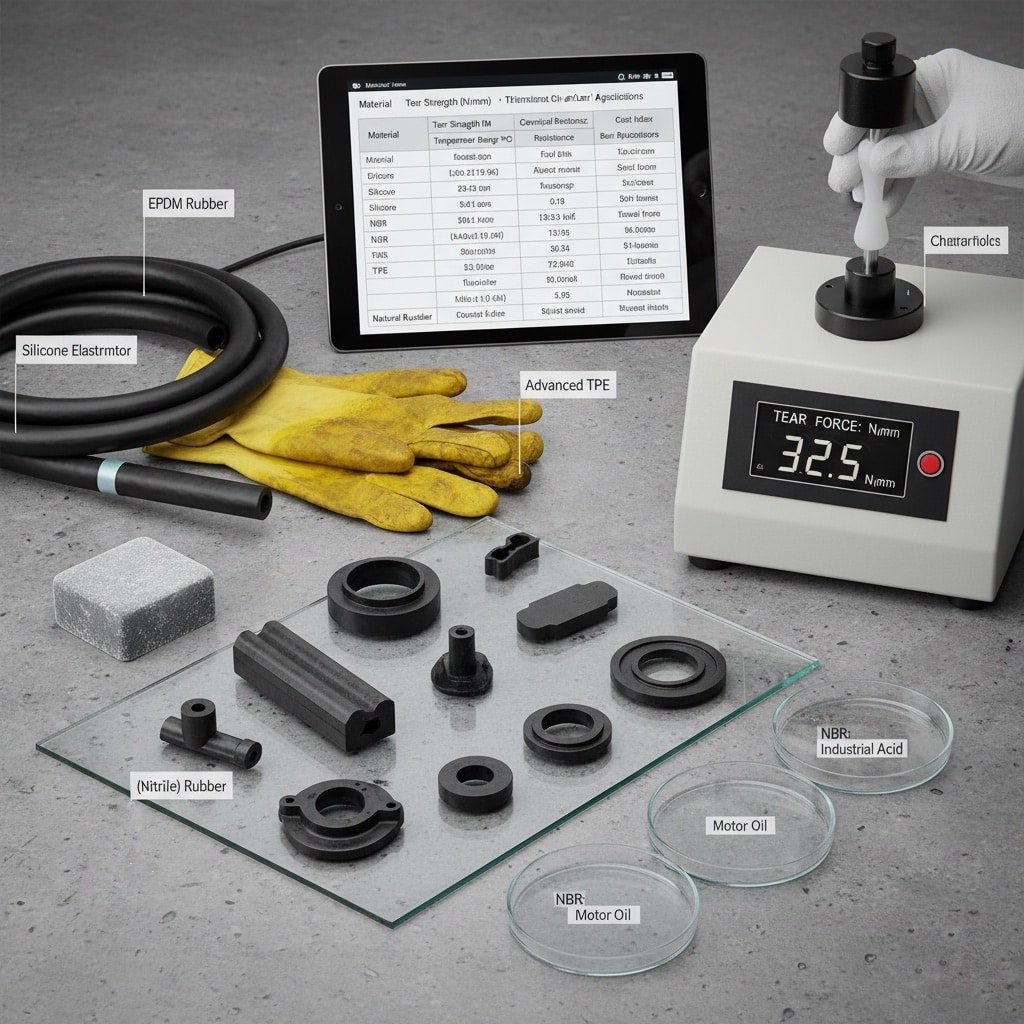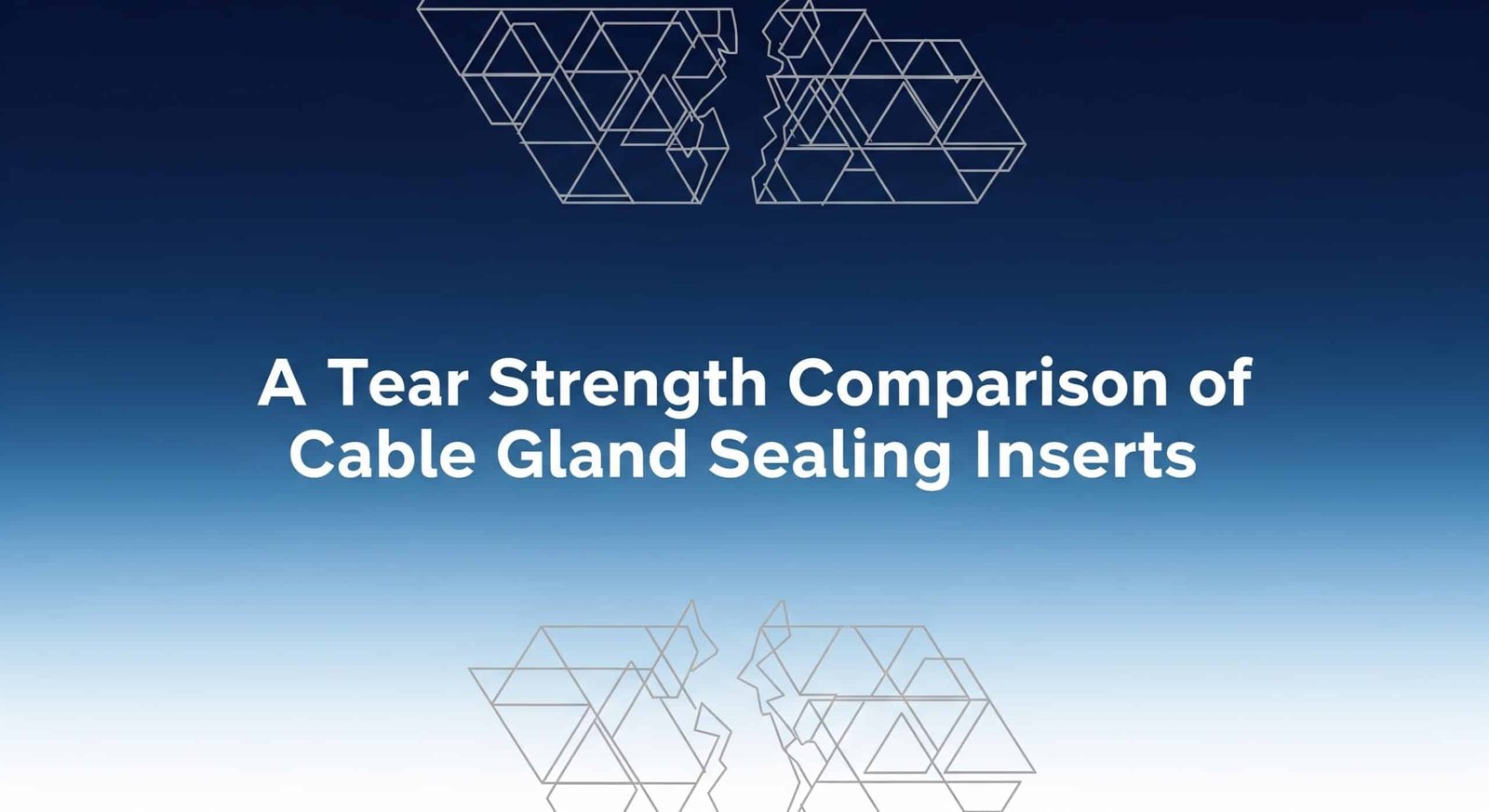
Cable gland failures cost industries millions annually, with over 60% of failures attributed to sealing insert degradation and tearing under mechanical stress. Many engineers select sealing inserts based solely on material type without considering critical tear strength properties, leading to premature failures, water ingress, and costly equipment damage.
Tear strength1 comparison of cable gland sealing inserts reveals that EPDM rubber inserts typically achieve 15-25 N/mm tear strength, silicone inserts reach 8-15 N/mm, while advanced TPE compounds can exceed 30 N/mm, making material selection critical for applications involving cable movement, vibration, or mechanical stress. Understanding these differences enables proper insert selection for reliable long-term sealing performance.
Last month, Jennifer Martinez, maintenance engineer at a wind farm in Texas, contacted us after experiencing repeated cable gland failures on turbine nacelles. The standard silicone sealing inserts were tearing within 6 months due to constant cable movement and wind-induced vibrations. After switching to our high tear strength TPE inserts, they’ve had zero failures over 18 months of operation! 😊
Innehållsförteckning
- What Factors Affect Cable Gland Sealing Insert Tear Strength?
- How Do Different Materials Compare in Tear Strength Performance?
- Which Applications Require High Tear Strength Sealing Inserts?
- How Can You Test and Measure Sealing Insert Tear Strength?
- What Are the Best Practices for Selecting High-Performance Sealing Inserts?
- FAQs About Cable Gland Sealing Insert Tear Strength
What Factors Affect Cable Gland Sealing Insert Tear Strength?
Understanding the key factors that influence sealing insert tear strength is essential for selecting the right materials and predicting long-term performance in demanding applications.
Primary factors affecting cable gland sealing insert tear strength include material composition and polymer type, manufacturing process and crosslinking2 density, operating temperature range, chemical exposure, mechanical stress patterns, and aging effects from UV radiation and ozone exposure. These factors interact to determine both initial tear strength and long-term durability under service conditions.

Material Composition and Polymer Structure
Polymer Chain Length: Longer polymer chains with higher molecular weight generally provide superior tear strength. Cross-linked elastomers show better resistance to crack propagation compared to thermoplastic materials.
Reinforcement Additives: Carbon black, silica, and aramid fiber reinforcements can increase tear strength by 200-400%. These additives create physical barriers that deflect crack propagation and distribute stress more evenly.
Innehåll av mjukgörare: While plasticizers improve flexibility, excessive amounts reduce tear strength. Optimal formulations balance flexibility with mechanical integrity for specific applications.
Påverkan på tillverkningsprocessen
Vulcanization Parameters: Proper curing temperature, time, and pressure create optimal crosslink density. Under-cured materials show poor tear strength, while over-curing creates brittleness.
Molding Conditions: Injection molding parameters affect molecular orientation and internal stress patterns. Proper gate design and cooling rates minimize weak points that initiate tearing.
Kvalitetskontroll: Consistent mixing, temperature control, and contamination prevention during manufacturing ensure uniform tear strength properties across production batches.
Stressfaktorer i miljön
Temperaturcykling: Repeated thermal expansion and contraction create internal stresses that reduce tear strength over time. Materials with low glass transition temperatures maintain flexibility at low temperatures.
UV and Ozone Exposure: Outdoor applications face degradation from UV radiation and ozone attack, which break polymer chains and reduce tear strength. Stabilizers and antioxidants help maintain properties.
Kemisk kompatibilitet: Exposure to oils, solvents, and cleaning chemicals can cause swelling, softening, or hardening that affects tear resistance. Material selection must consider specific chemical environments.
Mechanical Loading Patterns
Static vs. Dynamic Loading: Constant tension creates different failure modes compared to cyclic loading. Dynamic applications require materials with excellent fatigue resistance.
Stresskoncentration: Sharp edges, notches, or manufacturing defects create stress concentration points where tearing initiates. Design optimization minimizes these critical areas.
Multi-axial Stress: Real-world applications often involve complex stress patterns combining tension, compression, and shear forces that affect tear propagation behavior.
At Bepto, we conduct comprehensive material testing under various environmental conditions to understand how these factors affect our sealing insert performance, ensuring reliable selection for customer applications.
How Do Different Materials Compare in Tear Strength Performance?
Material selection significantly impacts sealing insert tear strength, with different elastomer and thermoplastic compounds showing distinct performance characteristics across various operating conditions.
EPDM rubber3 delivers excellent tear strength (15-25 N/mm) with superior weather resistance, silicone provides moderate strength (8-15 N/mm) with extreme temperature capability, NBR offers good strength (12-20 N/mm) with oil resistance, while advanced TPE compounds achieve exceptional performance (25-35 N/mm) combining high strength with processing advantages. Each material offers unique benefits for specific applications.
EPDM Rubber Performance
Tear Strength Characteristics: EPDM (Ethylene Propylene Diene Monomer) rubber typically achieves 15-25 N/mm tear strength depending on formulation and reinforcement. The saturated polymer backbone provides excellent resistance to crack propagation.
Temperaturprestanda: Maintains tear strength from -40°C to +150°C, making it ideal for outdoor applications with extreme temperature variations. Low temperature flexibility prevents brittle failure.
Environmental Resistance: Outstanding ozone, UV, and weather resistance maintains tear strength over decades of outdoor exposure. Chemical resistance to polar solvents and acids preserves mechanical properties.

Silicone Elastomer Properties
Mechanical Characteristics: Silicone elastomers show moderate tear strength (8-15 N/mm) but exceptional temperature stability. The Si-O backbone provides unique flexibility across extreme temperature ranges.
Extrema temperaturer: Maintains elasticity from -60°C to +200°C, though tear strength decreases at elevated temperatures. Excellent thermal cycling resistance prevents fatigue failure.
Kemisk inertitet: Exceptional chemical resistance to most industrial chemicals maintains consistent tear strength in aggressive environments. Food-grade formulations available for sanitary applications.
NBR (Nitrile) Rubber Analysis
Oil Resistance Advantage: NBR provides 12-20 N/mm tear strength with excellent oil and fuel resistance. Acrylonitrile content determines both oil resistance and tear strength properties.
Temperature Limitations: Effective from -30°C to +120°C, with tear strength declining at temperature extremes. Requires stabilizers for long-term heat aging resistance.
Cost-Performance Balance: Offers good tear strength at moderate cost, making it popular for industrial applications where oil resistance is required but extreme performance isn’t critical.
Advanced TPE Compounds
Superior Performance: Thermoplastic elastomers can achieve 25-35 N/mm tear strength through advanced polymer architecture and reinforcement systems. Combines elastomeric properties with thermoplastic processing.
Processing Advantages: Injection moldable with excellent dimensional control and minimal waste. Recyclable materials support sustainability initiatives while maintaining performance.
Customization Capability: Formulations can be tailored for specific applications, optimizing tear strength, chemical resistance, and temperature performance for exact requirements.
Jämförelsetabell för material
| Material | Tear Strength (N/mm) | Temperaturområde (°C) | Kemisk beständighet | Kostnadsindex | Bästa applikationer |
|---|---|---|---|---|---|
| EPDM | 15-25 | -40 till +150 | Utmärkt | 3 | Outdoor, Weather Exposed |
| Silikon | 8-15 | -60 to +200 | Utmärkt | 4 | Hög temperatur |
| NBR | 12-20 | -30 to +120 | Good (Oils) | 2 | Oil/Fuel Environments |
| TPE | 25-35 | -40 to +130 | Mycket bra | 3 | High Performance |
| Naturgummi | 20-30 | -20 to +80 | Dålig | 1 | Low Cost, Indoor |
Exempel på prestanda i den verkliga världen
Klaus Weber, engineering manager at a chemical plant in Germany, needed sealing inserts for cable glands on rotating equipment exposed to hydraulic oils and temperature cycling. Standard NBR inserts were failing due to insufficient tear strength under dynamic loading. We recommended our reinforced TPE compound with 30 N/mm tear strength, resulting in 5x longer service life and 60% reduction in maintenance costs.
Which Applications Require High Tear Strength Sealing Inserts?
Identifying applications that demand superior tear strength helps engineers select appropriate sealing inserts and prevent costly failures in critical systems.
Applications requiring high tear strength sealing inserts include rotating machinery with cable movement, outdoor installations subject to wind loading, mobile equipment experiencing vibration and shock, marine environments with wave action, and industrial processes involving thermal cycling or chemical exposure. These demanding conditions create mechanical stresses that can cause standard inserts to fail prematurely.
Rotating and Moving Equipment
Wind Turbines: Nacelle cable glands experience constant cable movement from rotor rotation and wind-induced vibrations. Tear strength requirements typically exceed 20 N/mm to prevent insert failure from fatigue loading.
Industriella maskiner: Rotating equipment, conveyor systems, and robotic applications create cyclic loading on cable glands. High tear strength inserts prevent progressive crack growth under repeated stress cycles.
Mobil utrustning: Construction machinery, mining equipment, and agricultural vehicles subject cable glands to shock loading, vibration, and cable flexing that demands superior tear resistance.
Harsh Environmental Conditions
Marina tillämpningar: Wave action, salt spray, and temperature cycling create demanding conditions for sealing inserts. Offshore platforms and ship installations require tear strength above 18 N/mm for reliable performance.
Installationer utomhus: Solar farms, telecommunications towers, and outdoor lighting systems face UV exposure, temperature extremes, and wind loading that can cause insert degradation and tearing.
Kemisk bearbetning: Plants handling aggressive chemicals need inserts that maintain tear strength despite chemical exposure. Swelling or hardening from chemical attack can reduce tear resistance significantly.
Miljöer med höga vibrationer
Transportsystem: Railway applications, automotive installations, and aerospace systems create high-frequency vibrations that can cause fatigue failure in standard sealing inserts.
Kraftgenerering: Generator sets, compressor stations, and pumping systems produce vibrations that stress cable gland seals. High tear strength prevents crack initiation and propagation.
Manufacturing Equipment: High-speed machinery, stamping presses, and automated production lines generate vibrations that require superior sealing insert performance.
Critical Safety Applications
Installationer i farliga områden: Explosion-proof cable glands in chemical plants, refineries, and gas processing facilities cannot tolerate seal failures that could compromise safety certifications.
Emergency Systems: Fire suppression, emergency lighting, and safety shutdown systems require ultra-reliable sealing that maintains integrity under all conditions.
Medicinsk utrustning: Hospital installations, pharmaceutical manufacturing, and medical device applications demand consistent sealing performance to prevent contamination or system failures.
Applikationsspecifika krav
| Tillämpningskategori | Minimum Tear Strength | Key Stress Factors | Rekommenderade material |
|---|---|---|---|
| Wind Energy | 20-25 N/mm | Cable Movement, Weather | EPDM, TPE |
| Marin/Offshore | 18-22 N/mm | Salt Water, Waves | EPDM, Fluoroelastomer |
| Kemisk bearbetning | 15-20 N/mm | Kemisk exponering | FFKM, EPDM |
| Mobil utrustning | 22-28 N/mm | Shock, Vibration | TPE, NBR |
| Hög temperatur | 12-18 N/mm | Thermal Cycling | Silicone, EPDM |
Selection Criteria for Demanding Applications
Load Analysis: Calculate expected stress levels from cable movement, vibration, and environmental factors. Include safety factors for unexpected loading conditions.
Miljöbedömning: Evaluate temperature ranges, chemical exposure, UV radiation, and other environmental factors that affect material properties over time.
Krav på livscykeln: Consider expected service life, maintenance intervals, and replacement costs when selecting high-performance materials for critical applications.
Ahmed Hassan, operations manager at a petrochemical facility in Saudi Arabia, learned this lesson when standard sealing inserts failed repeatedly on critical pump motor cable glands. The combination of vibration, temperature cycling, and chemical exposure required our premium TPE inserts with 28 N/mm tear strength. Since installation, they’ve achieved 99.8% reliability over three years of continuous operation.
How Can You Test and Measure Sealing Insert Tear Strength?
Proper testing and measurement of sealing insert tear strength ensures reliable material selection and quality control for critical applications.
Standard tear strength testing methods include ASTM D6244 trouser tear test, ISO 34 angle tear test, and DIN 53515 crescent tear test, with results typically expressed in N/mm or lbf/in. Testing should be conducted at operating temperatures and after environmental conditioning to simulate real-world performance conditions. Proper test specimen preparation and standardized procedures ensure reproducible and meaningful results.
Standardiserade testmetoder
ASTM D624 Trouser Tear Test: The most common method uses a trouser-shaped specimen with a pre-cut notch. Force is applied to separate the legs while measuring the force required to propagate the tear. Results are expressed as force per unit thickness.
ISO 34 Method B (Angle Tear): Uses a rectangular specimen with a 90-degree angle cut. The specimen is pulled apart at the angle, measuring the maximum force before tearing begins. This method simulates stress concentration conditions.
DIN 53515 Crescent Tear Test: Employs a crescent-shaped specimen that creates uniform stress distribution. This method provides good correlation with service performance in many applications.
Förberedelse av provkroppar
Materialkonditionering: Specimens must be conditioned at standard temperature (23°C ± 2°C) and humidity for minimum 16 hours before testing. This ensures consistent baseline properties.
Cutting Precision: Sharp, clean cuts are essential for reproducible results. Dull blades or rough cuts create stress concentrations that affect tear initiation and propagation.
Thickness Measurement: Accurate thickness measurement is critical since tear strength is normalized by specimen thickness. Use calibrated micrometers with 0.01mm resolution.
Environmental Testing Conditions
Temperaturprovning: Conduct tests at minimum, maximum, and intermediate operating temperatures to understand performance across the service range. Low temperature testing often reveals brittle failure modes.
Aged Specimen Testing: Age specimens in relevant environments (heat, UV, ozone, chemicals) before testing to simulate long-term service conditions. Compare aged vs. unaged performance.
Wet Condition Testing: Test specimens after water immersion or high humidity exposure to evaluate moisture effects on tear strength properties.
Analys och tolkning av data
Statistisk analys: Test minimum 5 specimens per condition and calculate mean, standard deviation, and confidence intervals. Identify and investigate outlier results.
Failure Mode Analysis: Document whether failure occurs by tearing through the material or by separation at interfaces. Different failure modes indicate different material properties.
Temperature Correlation: Plot tear strength vs. temperature to identify glass transition effects and establish operating temperature limits for reliable performance.
Testning av kvalitetskontroll
Inspektion av inkommande material: Test representative samples from each material lot to verify tear strength meets specifications. Establish acceptance criteria and rejection procedures.
Processtyrning: Monitor tear strength during production to detect process variations that affect material properties. Use control charts to identify trends.
Validering av färdig produkt: Test completed sealing inserts to verify that molding processes haven’t degraded tear strength properties through thermal or mechanical damage.
Field Correlation Studies
Förutsägelse av livslängd: Correlate laboratory tear strength data with field performance to develop predictive models for service life estimation under various operating conditions.
Analys av fel: When field failures occur, conduct tear strength testing on failed components to understand degradation mechanisms and improve material selection.
Accelererad testning: Develop accelerated test protocols that compress years of service into weeks of laboratory testing while maintaining correlation with field performance.
Krav på testutrustning
| Testmetod | Equipment Needed | Specimen Size | Test Speed | Typical Results |
|---|---|---|---|---|
| ASTM D624 | Universal Testing Machine5 | 150mm x 25mm | 500 mm/min | 15-35 N/mm |
| ISO 34-B | Tensile Tester | 50mm x 50mm | 100 mm/min | 10-30 N/mm |
| DIN 53515 | Material Tester | Crescent Shape | 200 mm/min | 12-28 N/mm |
At Bepto, our quality laboratory maintains ISO 17025 accreditation for tear strength testing, ensuring accurate and traceable results that customers can rely on for critical material selection decisions. We test every material lot and provide certified test reports with each shipment.
What Are the Best Practices for Selecting High-Performance Sealing Inserts?
Implementing systematic selection criteria and best practices ensures optimal sealing insert performance while minimizing lifecycle costs and maintenance requirements.
Best practices for selecting high-performance sealing inserts include conducting thorough application analysis, specifying minimum tear strength requirements based on stress calculations, evaluating material compatibility with environmental conditions, considering long-term aging effects, and implementing quality assurance programs with certified suppliers. Following these practices prevents premature failures and optimizes total cost of ownership.
Ramverk för applikationsanalys
Stress Assessment: Calculate expected mechanical stresses from cable movement, vibration, thermal expansion, and installation forces. Include dynamic loading factors and safety margins for unexpected conditions.
Environmental Mapping: Document all environmental exposures including temperature ranges, chemical contact, UV radiation, ozone levels, and humidity conditions throughout the expected service life.
Krav på prestanda: Define minimum tear strength, temperature limits, chemical resistance, and service life expectations based on application criticality and maintenance accessibility.
Kriterier för materialval
Primary Performance Metrics: Establish minimum tear strength requirements based on calculated stress levels plus appropriate safety factors. Consider both initial properties and aged performance.
Secondary Properties: Evaluate compression set, tensile strength, elongation, and hardness to ensure overall mechanical performance meets application demands.
Stabilitet på lång sikt: Review heat aging, ozone resistance, and chemical compatibility data to predict property retention over the expected service life.
Process för kvalificering av leverantörer
Quality System Assessment: Verify suppliers maintain ISO 9001 or equivalent quality management systems with documented material control and testing procedures.
Teknisk kapacitet: Evaluate supplier’s material expertise, testing capabilities, and ability to provide technical support for material selection and problem-solving.
Supply Chain Reliability: Assess production capacity, inventory management, and delivery performance to ensure reliable material availability for critical applications.
Test- och valideringsprogram
Inkommande inspektion: Establish acceptance criteria for tear strength and other critical properties. Test representative samples from each material lot before use.
Application Testing: Conduct application-specific testing under simulated service conditions to validate material selection before full implementation.
Field Monitoring: Implement inspection schedules and performance monitoring to track actual service life and identify optimization opportunities.
Optimering av kostnad och nytta
Analys av livscykelkostnader: Compare initial material costs with expected service life, maintenance requirements, and failure consequences to optimize total cost of ownership.
Performance vs. Cost Trade-offs: Evaluate whether premium materials with higher tear strength provide sufficient value through extended service life and reduced maintenance.
Riskbedömning: Consider consequences of seal failure including safety risks, environmental impact, production losses, and repair costs when selecting materials.
Installation and Handling Guidelines
Storage Requirements: Maintain proper storage conditions to prevent material degradation before installation. Control temperature, humidity, and UV exposure.
Installationsförfaranden: Develop specific procedures for sealing insert installation including proper tools, torque specifications, and damage prevention measures.
Utbildningsprogram: Ensure installation personnel understand material properties, handling requirements, and proper installation techniques for optimal performance.
Övervakning och optimering av prestanda
Inspektionsscheman: Establish regular inspection intervals based on application criticality and expected service life. Document findings and trends.
Analys av fel: When failures occur, conduct root cause analysis to identify whether the issue is material selection, installation, or unexpected service conditions.
Kontinuerlig förbättring: Use performance data to refine material selection criteria, update specifications, and optimize maintenance schedules for improved reliability.
Beslutsmatris för urval
| Application Factor | Vikt | EPDM | Silikon | NBR | TPE | Scoring Criteria |
|---|---|---|---|---|---|---|
| Tear Strength | 30% | 8 | 5 | 7 | 9 | 1-10 scale |
| Temperaturområde | 20% | 8 | 10 | 6 | 7 | Operating range |
| Kemisk beständighet | 20% | 9 | 9 | 7 | 8 | Kompatibilitet |
| Kostnad | 15% | 7 | 5 | 9 | 6 | Relative cost |
| Tillgänglighet | 15% | 9 | 8 | 9 | 7 | Supply reliability |
Strategi för genomförande
Pilot Programs: Start with small-scale implementations to validate material selection and performance before full deployment across similar applications.
Dokumentation: Maintain detailed records of material selections, performance data, and lessons learned to support future decision-making and continuous improvement.
Vendor Partnerships: Develop strategic relationships with qualified suppliers who can provide technical support, custom formulations, and reliable supply for critical applications.
Maria Rodriguez, chief engineer at a solar farm in Arizona, implemented our systematic selection process after experiencing frequent sealing insert failures in their harsh desert environment. By following our application analysis framework and selecting TPE inserts with 25 N/mm tear strength, they reduced failure rates by 90% and extended maintenance intervals from 6 months to 3 years, saving over $150,000 annually in maintenance costs.
Slutsats
Tear strength comparison of cable gland sealing inserts reveals significant performance differences between materials, with advanced TPE compounds achieving 25-35 N/mm compared to 8-15 N/mm for silicone elastomers. Understanding these differences, along with environmental factors affecting tear strength, enables proper material selection for demanding applications. Systematic testing using standardized methods like ASTM D624 provides reliable data for material qualification and quality control. Best practices including thorough application analysis, environmental assessment, and lifecycle cost evaluation ensure optimal sealing insert selection. At Bepto, our comprehensive material testing and technical expertise help customers select the right sealing inserts for their specific applications, ensuring reliable long-term performance and minimizing total cost of ownership through reduced maintenance and extended service life.
FAQs About Cable Gland Sealing Insert Tear Strength
Q: What is considered good tear strength for cable gland sealing inserts?
A: Good tear strength typically ranges from 15-25 N/mm for standard applications, while demanding environments require 25+ N/mm. The specific requirement depends on cable movement, vibration levels, and environmental conditions in your application.
F: Hur påverkar temperaturen förseglingens rivhållfasthet?
A: Most elastomers show decreased tear strength at elevated temperatures and increased brittleness at low temperatures. EPDM maintains good tear strength from -40°C to +150°C, while silicone performs well from -60°C to +200°C but with lower absolute values.
Q: Can I test tear strength of installed sealing inserts?
A: Direct tear strength testing requires destructive testing of the insert, so it’s not practical for installed components. Instead, use visual inspection for cracking, hardness testing, or compression set measurements to assess condition and remaining service life.
Q: Why do some sealing inserts fail even with high tear strength ratings?
A: High tear strength alone doesn’t guarantee success – chemical compatibility, proper installation, appropriate hardness, and environmental resistance are equally important. Failures often result from chemical degradation, improper installation, or unexpected environmental exposures rather than insufficient tear strength.
Q: How often should I replace sealing inserts in high-stress applications?
A: Replacement intervals depend on tear strength requirements, environmental conditions, and application criticality. High-stress applications typically require replacement every 2-5 years, while standard applications may last 10+ years with proper material selection and installation.
-
Learn the definition of tear strength, a measure of a material’s resistance to the growth of a cut or tear under tension. ↩
-
Understand the process of crosslinking, where polymer chains are chemically joined to form a three-dimensional network. ↩
-
Explore the characteristics of Ethylene Propylene Diene Monomer (EPDM) rubber, known for its excellent weather and heat resistance. ↩
-
Review the scope of the ASTM D624 standard, which covers the “trouser tear” test method for conventional vulcanized thermoset rubber. ↩
-
Discover the principles of a Universal Testing Machine (UTM), used to perform tensile, compressive, and bend tests on materials. ↩


